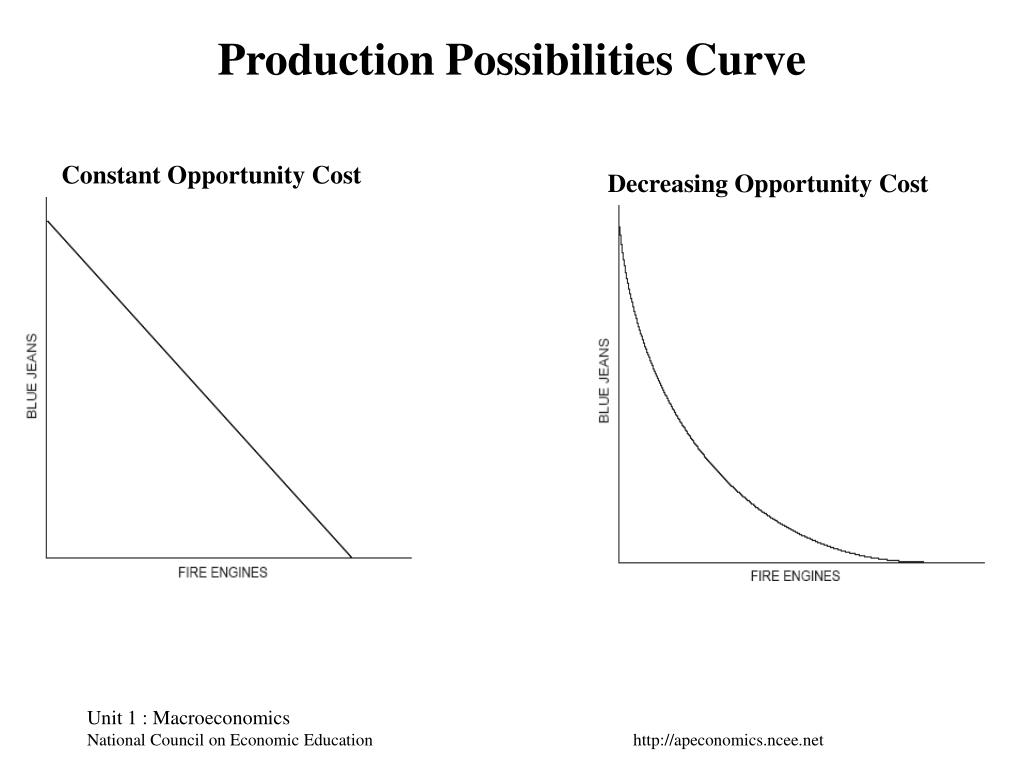

Working through this example shows that the PPC curve can also tell us the difference between increasing opportunity costs and constant opportunity costs. Economically, my opportunity cost of making hamburgers is rising. I’m giving up more pizzas to move from D to E then I did from moving from C to D, even though I’m making fewer hamburgers. Then, moving one step further, from 10 hamburgers to 11 hamburgers means that I have to give up 15 pizzas. To move from making 8 hamburgers to 10 hamburgers, I have to give up 10 pizzas.

To highlight this, consider moving from C to D and then from D to E. In this example, my opportunity costs are what I give up in order to produce more pizzas or more hamburgers. Opportunity costs are key to understanding both AP® Microeconomics and AP® Macroeconomics, and the production possibilities curve lets us clearly visualize them. The combination of scarcity and trade-offs brings us to opportunity costs.

So, we can see the trade-off that is inherent to the last hamburger I decide to make-namely, I give up the 15 pizzas that I could have made. If I’m willing to make 1 less hamburger though, the PPC shows that I could make 15 pizzas. The PPC curve shows us that if I spend my entire day making hamburgers, I can make 11 of them. Let’s say that I’m spending all of my time making hamburgers. Because time is a scarce resource, when choosing to make more hamburgers or more pizzas, I have to consider the inherent trade-off created. Likewise, the production possibilities curve demonstrates the vital economic concept of trade-offs. Because there are only so many hours in a day, as I spend more time focusing on making pizzas, I simply cannot make as many hamburgers. I can spend my entire day making 32 pizzas, but this means that I will have no more time available to make a hamburger. To illustrate, let’s look at each of these concepts in the context of our simple example.įirst, how does the PPC curve demonstrate scarcity? In this case, the scarce resource is the number of hours in a day available to me. In particular, the PPC curve demonstrates scarcity, trade-offs, opportunity costs, and economic efficiency. Knowing the production possibilities curve is key to your AP® Economics review because it brings together a number of economic concepts.
PRODUCTION POSSIBILITIES CURVE HOW TO
Now that we’ve seen how to put together a simple example, let’s find out what makes this concept so relevant to studying for AP® Macroeconomics and AP® Microeconomics! What’s so Important About the PPC? We can see that the graph of the production possibilities curve in our simple example demonstrates visually the different production opportunities that are available to me, depending on the length of time I want to spend making either pizzas or hamburgers. This outward bowed PPC should look roughly similar to the graph at the beginning of this post. Hey! Where did point F come from? For now, ignore F, but we will come back to it when we discuss efficiency.

Now that we know exactly what my production possibilities are. This means I may have a set of production possibilities that looks like the following table: For example, during the day, I can make pizzas or hamburgers, and I only have so much time. It’s easiest to start by thinking about the production possibilities available to any person, like you or me. We’ll start by working out what exactly a production possibilities curve is by thinking through a simple example. In this post, we’ll build our understanding of the production possibilities curve from the ground up and work through some practice questions together so let’s get started! A Simple Example First and foremost, you’ll definitively need to master this concept if you want to ace your AP® Microeconomics or AP® Macroeconomics exams, of course! Beyond that, the PPC curve gives you an opportunity to make sure you’ve got a handle on some important economics subjects, such as opportunity costs and efficiency. The production possibilities curve is a crucial part of any AP® Economics review for a couple of reasons. So what is the production possibilities curve? The PPC curve is a way to represent the different production opportunities for a person, country, or trading partners. In that case, the production possibilities curve, sometimes called the production possibilities frontier, is a concept that you’ve got to know! Introduction to Production Possibilities Curve So you’ve started studying for the AP® Microeconomics and AP® Macroeconomics exams, and you want to know what’s essential for your AP® Economics review.


 0 kommentar(er)
0 kommentar(er)
